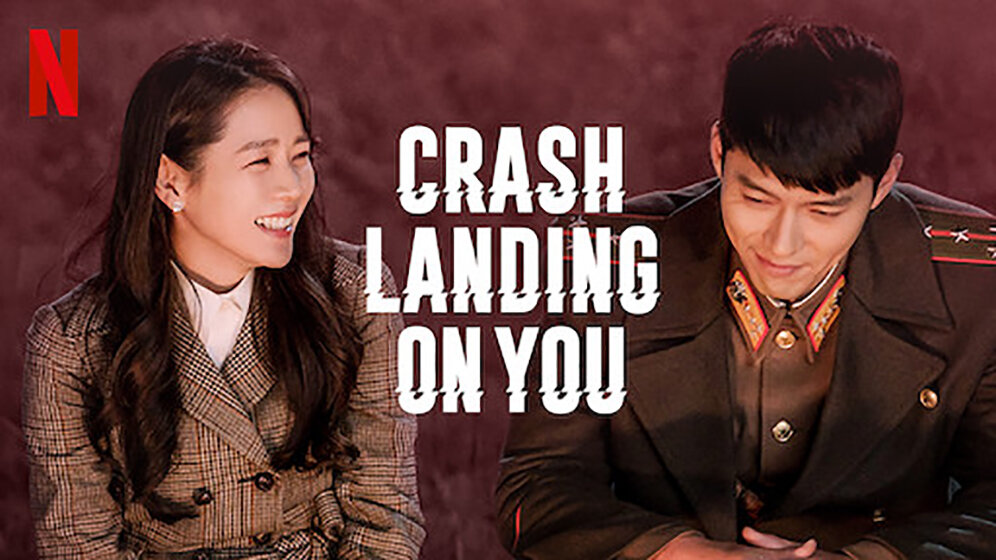Written by Yoon (Intern for Crossing Borders)
It would be an understatement to say that Netflix’s Crash Landing On You has been one of 2020’s biggest television hits. According to Nielsen Korea, ratings peaked at 24.1 percent as the show quickly became the second-highest-rated Korean cable drama in history. With its first episode airing in December of 2019 and the series finale in February of 2020, the show seemed to be a perfect package delivered just in time for the quarantine bingefests. The show tells a tale of two star-crossed lovers, which becomes a vehicle to highlight the show’s true appeal: a rare glimpse into North Korea.
Mostly shot in South Korea and Switzerland, the romantic comedy follows the love story of chaebol (a member of South Korea’s economic elite) Yoon Se-Ri, heiress to her family’s powerful conglomerate, who accidentally paraglides across the DMZ into North Korea and literally falls into the arms of Ri Jeong-Hyeok, a captain of the North Korean army and son of one of the highest political figures in the regime. Se-Ri, whose unpowered paraglide managed to slide by the border undetected, must now remain hidden in Jeong-Hyeok’s nearby rural village and find a way to re-enter South Korea, all the while falling in love with Captain Ri and facing the consequences that ensue.
As endearingly unrealistic as this may already sound, the show also features a number of additional k-drama tropes that are all too familiar: a crew of goofy side characters, a council of village ahjummas (middle-aged women), a play of money politics by the Korean elite and a threatening villain from whom the protagonists must protect one another. The spin this time, however, is that much of the story takes place on the other side of the Korean border, in a country so inaccessible on television and even less so in real life.
What I, along with many others, found most interesting about the show was the peek into mundane life in North Korea. Much of what is depicted in Crash Landing is like a slightly distorted mirror of what we see in South Korea— certain aspects of society seem like a carbon copy while others are dramatically different. One of the features my parents, in particular, enjoyed while watching this show was hearing the dialects of the North Korean villagers and seeing the slight nuances in commonly used Korean phrases that are highlighted in the subtitles. Following this, the ambience of the marketplaces and rural village neighborhoods somehow seem reminiscent of a South Korea from the distant past. My mom even mentioned to me that her friend, who grew up in rural South Korea, remembers taking part in the morning village exercises before school that the show’s North Korean children participate in.
On the other hand, the series also features elements of North Korea that are less recognizable to those from the South: frequent blackouts due to the electricity shortage, propaganda-projecting bullhorns perched throughout the village and hungry orphans hiding under marketplace tents. The series also includes the two countries’ primary divergence— namely, North Korea’s extremely oppressive communist government. Although the Kim dynasty is rarely mentioned in the show explicitly, the drama portrays the brutal prison camps and secret political tactics that we know are present within the country. More than anything, however, what I find the show captures most powerfully is simply what it must feel like to live under a regime as ruthless and silencing as that of North Korea. The government-mandated house checks, microphone bugs, and underground network of eavesdroppers make even the viewers feel as if they are a vulnerable threat.
It is very likely that the show is not an entirely accurate portrayal of life in North Korea. Although the creators recruited a North Korean defector to help write the script and piece together his knowledge of this secret country, many have noted that the show depicts North Korea as more pleasant than it really is. Still other details are certainly questionable as well, such as the super-rich Pyongyang family who sends their daughter off to study abroad in Switzerland and the young North Korean soldier who secretly watches k-dramas from the south.
Despite the myths that may need to be verified, however, one thing that is undeniable is that Crash Landing on You paints a picture of North Korea that has not been envisioned before. No matter how inaccurate or dramaticized it may be, this portrait is perhaps one of the only forms of media that offers an alternative narrative to the cold, mechanistic headlines of North Korea we see too often; rather, it is a human story that draws on more than just a paranoid dictator and his obsession with nuclear weapons. For the first time, this show dares to imagine, if even just a caricature, what daily life for North Korean people may or may not look like.
After watching the series and noting its viral impact, the one thing I took away from Crash Landing on You is this: people are curious about North Korea. Without even knowing it ourselves, we are itching to know and to see what lies behind the walls of the world’s most reclusive country— even if we have to imagine it. When you think about it this way, the connection between a lighthearted k-drama and an organization like Crossing Borders is more closely tied than it may seem. Evidently, there is a side of us that wants to imagine North Korea in all its humanity, to hear stories of real people and to match them with their actual faces and names— perhaps of those like the refugees and orphans Crossing Borders ministers to today. And if we can channel this kind of curiosity and interest in the North Korean people towards a compassion to genuinely serve and pray for them, well, we may just be on the right track.


